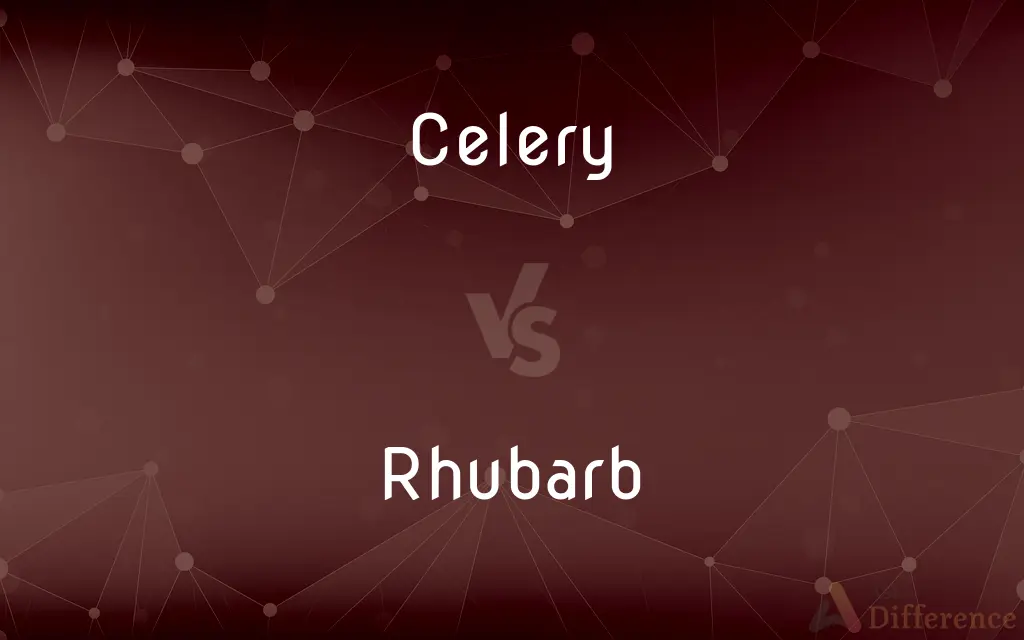Celery vs. Rhubarb — What's the Difference?

Difference Between Celery and Rhubarb
ADVERTISEMENT
Compare with Definitions
Celery
Celery (Apium graveolens) is a marshland plant in the family Apiaceae that has been cultivated as a vegetable since antiquity. Celery has a long fibrous stalk tapering into leaves.
Rhubarb
Rhubarb is the fleshy, edible stalks (petioles) of species and hybrids (culinary rhubarb) of Rheum in the family Polygonaceae, which are cooked and used for food. The whole plant – a herbaceous perennial growing from short, thick rhizomes – is also called rhubarb.
Celery
A biennial European plant (Apium graveolens var. dulce) in the parsley family, having edible roots, leafstalks, leaves, and fruits.
Rhubarb
Any of several plants of the genus Rheum, especially R. rhabarbarum, having long edible green or reddish leafstalks that are usually cooked and sweetened. Also called pie plant.
Celery
The crisp thick leafstalks of this plant.
ADVERTISEMENT
Rhubarb
A preparation made from the dried rhizomes and roots of any of several plants of the genus Rheum, especially R. palmatum or R. officinale of East Asia, used as a laxative.
Celery
The seedlike fruits of this plant used as a flavoring.
Rhubarb
(Informal)A quarrel, fight, or heated discussion.
Celery
A European herb (Apium graveolens) of the carrot family.
Rhubarb
Any plant of the genus Rheum, especially Rheum rhabarbarum, having large leaves and long green or reddish acidic leafstalks that are edible, in particular when cooked (although the leaves are mildly poisonous).
Celery
(uncountable) The stalks of this herb eaten as a vegetable.
Rhubarb
The leafstalks of common rhubarb or garden rhubarb (usually known as Rheum × hybridum), which are long, fleshy, often pale red, and with a tart taste, used as a food ingredient; they are frequently stewed with sugar and made into jam or used in crumbles, pies, etc.
Celery
A yellow-green colour, like that of a celery.
Rhubarb
The dried rhizome and roots of Rheum palmatum (Chinese rhubarb) or Rheum officinale (Tibetan rhubarb), from China, used as a laxative and purgative.
Celery
A plant of the Parsley family (Apium graveolens), of which the blanched leafstalks are used as a salad.
Rhubarb
A Royal Air Force World War II code name for operations by aircraft (fighters and fighter-bombers) involving low-level flight to seek opportunistic targets.
Celery
Widely cultivated herb with aromatic leaf stalks that are eaten raw or cooked
Rhubarb
(Saskatchewan) A ditch alongside a road or highway.
Driving home yesterday, I almost hit the rhubarb.
Celery
Stalks eaten raw or cooked or used as seasoning
Rhubarb
General background noise caused by several simultaneous indecipherable conversations, which is created in films, stage plays, etc., by actors repeating the word rhubarb; hence, such noise in other settings.
Rhubarb
Nonsense; false utterance.
Rhubarb
An excited, angry exchange of words, especially at a sporting event.
Rhubarb
A brawl.
Rhubarb
Of the colour of rhubarb: either brownish-yellow (the colour of rhubarb rhizomes and roots used for medicinal purposes), or pale red (often the colour of the leafstalks of common rhubarb).
Rhubarb
Of fighter aircraft: to fire at a target opportunistically.
Rhubarb
Of an actor in a film, stage play, etc.: to repeat the word rhubarb to create the sound of indistinct conversation; hence, to converse indistinctly, to mumble.
Rhubarb
(transitive) To articulate indistinctly or mumble (words or phrases); to say inconsequential or vague things because one does not know what to say, or to stall for time.
Rhubarb
The name of several large perennial herbs of the genus Rheum and order Polygonaceæ.
Rhubarb
The large and fleshy leafstalks of Rheum Rhaponticum and other species of the same genus. They are pleasantly acid, and are used in cookery. Called also pieplant.
Rhubarb
The root of several species of Rheum, used much as a cathartic medicine.
Rhubarb
Long pinkish sour leafstalks usually eaten cooked and sweetened
Rhubarb
Plants having long green or reddish acidic leafstalks growing in basal clumps; stems (and only the stems) are edible when cooked; leaves are poisonous
Share Your Discovery

Previous Comparison
Archetype vs. Meme
Next Comparison
Heptane vs. Septane














































